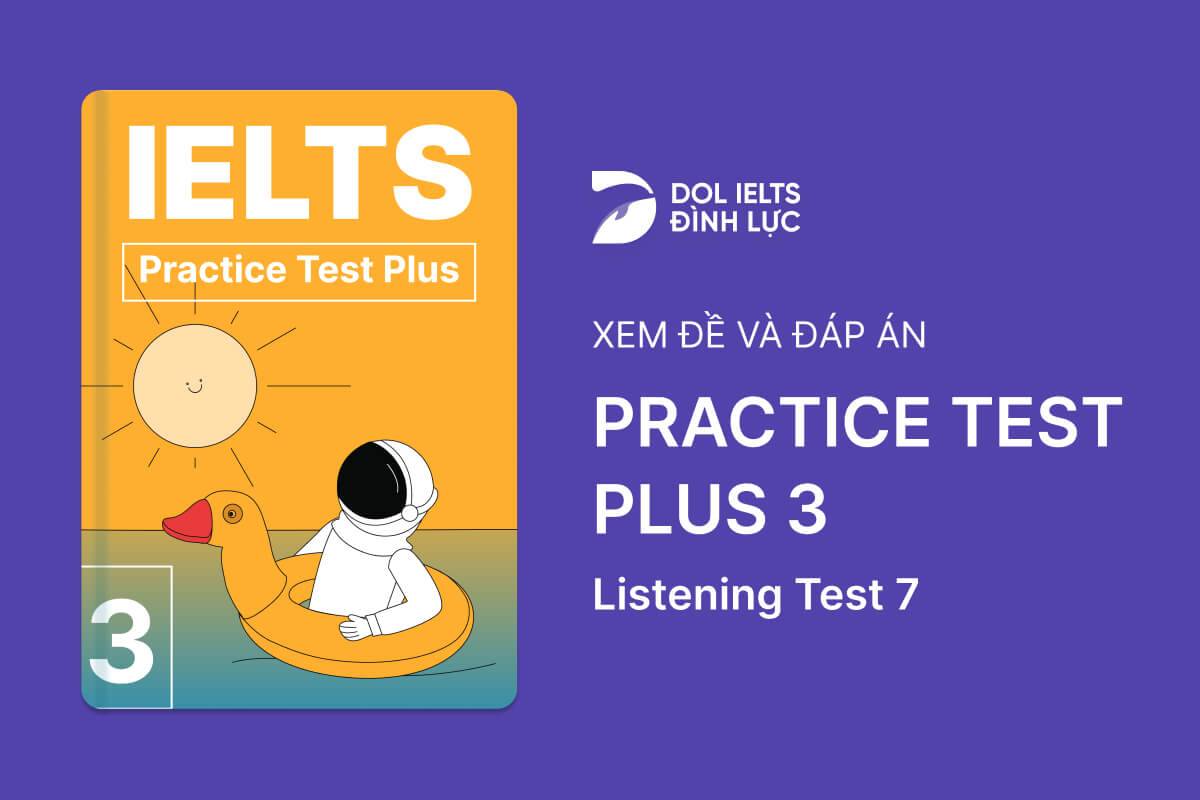Đề thi IELTS Online Test Practice Test Plus 3 - Listening Test 7 - Download PDF Câu hỏi, Transcript và Đáp án
Luyện tập đề IELTS Online Test Practice Test Plus 3 - Listening Test 7 được lấy từ cuốn sách Practice Test Plus 3 với trải nghiệm thi IELTS trên máy và giải thích đáp án chi tiết bằng Linearthinking, kèm answer key và list từ vựng IELTS cần học trong bài đọc.
Section
👂️ Bài nghe section 1
must find out which
arriving at1
best taxi company
2
Note: Simon lives in the
of the city3
Simon’s cell phone number:
4
casual clothes
one smart dress - to wear at a
5
a good
6
tough
7
try to find book named
by Rex Campbell.8
for Janice:
9
for Alec:
(with racing pictures)10
❓ Tapescript section 1
🔥 Đáp án & giải thích section 1
Giải thích chi tiết
Đáp án là một danh từ chỉ địa điểm (must find out which ___ arriving at)
 Đầu tiên Simon hỏi ''I presume you’ll be coming into Terminal One?'
Đầu tiên Simon hỏi ''I presume you’ll be coming into Terminal One?'
Nhưng Tanya trả lời là ''I don’t know ... I’ll have to find out which one it is ...''
=> Simon hỏi có phải cô ấy sẽ tới ở Cổng 1 không nhưng ô ấy không biết cổng nào mình sẽ tới và cô ấy sẽ phải tra lại chính xác là cổng nào
=> Đáp án: terminal 
Section
👂️ Bài nghe section 2
❓ Tapescript section 2
🔥 Đáp án & giải thích section 2
Giải thích chi tiết
 Mình cần tìm điểm khác biệt ở Camber's Park với những chỗ khác
Mình cần tìm điểm khác biệt ở Camber's Park với những chỗ khác
=> Đáp án sẽ có sau ''We like to think that Camber’s offers more than other theme parks.''
 Đầu tiên, ''Like them, we have a variety of exciting rides for people of all ages,''
Đầu tiên, ''Like them, we have a variety of exciting rides for people of all ages,''
=> Chúng đều có điểm giống nhau là phù hợp với nhiều lứa tuổi khác nhau
=> Loại đáp án A 
 Sau đó, ''but Camber’s also places strong emphasis on the educational experience for its visitors''
Sau đó, ''but Camber’s also places strong emphasis on the educational experience for its visitors''
=> Tuy nhiên, điểm khác biệt là Camber đặt nặng hơn vào sự giáo dục (but chỉ ý đối lập, ý nói sự khác biệt)
=> Đáp án là C 
 Cuối cùng, ''Although it’s mainly an outdoor experience, we do have some indoor activities if the weather gets too dreadful.''
Cuối cùng, ''Although it’s mainly an outdoor experience, we do have some indoor activities if the weather gets too dreadful.''
=> Camber cũng có các hoạt động trong nhà khi trời mưa, tuy nhiên người nói không bảo đây là điểm khác biệt mà chỉ giới thiệu thôi
=> Loại đáp án B 
Section
👂️ Bài nghe section 3
❓ Tapescript section 3
🔥 Đáp án & giải thích section 3
Giải thích chi tiết
 Mình cần nghe xem họ nghĩ gì về việc listening in groups
Mình cần nghe xem họ nghĩ gì về việc listening in groups
=> Đáp án sẽ có sau ''I suggest we start with listening.''
 Đầu tiên, ''because it’s not something that’s frequently covered on courses in our field ...''
Đầu tiên, ''because it’s not something that’s frequently covered on courses in our field ...''
Helen cũng đồng ý, ''No ... and we should say that in the presentation.''
=> Kỹ năng nghe không được dạy thường xuyên trong chuyên ngành của họ (theo đề bài, chuyên ngành của họ là business)
=> Đáp án là A 
 Thứ hai, Brad nói là ''And also effective listening’s pretty simple, you know, I don’t think it’s hard to learn.'' (ứng với đáp án B).
Thứ hai, Brad nói là ''And also effective listening’s pretty simple, you know, I don’t think it’s hard to learn.'' (ứng với đáp án B).
Tuy nhiên Helen không đồng ý, ''people think it’s easy, but in my experience most of us tend to be very lazy listeners.
Section
👂️ Bài nghe section 4
Short growing season because of high altitude and low
31
Fresh vegetables imported by lorry or by
, so are expensive32
Need to use sunlight to prevent local plants from
33
Previous programmes to provide greenhouses were
34
Simple and to build
35
Made mainly from local materials (mud or stone for the walls, wood and
for the roof)36
Building and maintenance done by local craftsmen
Runs solely on
energy37
Only families who have a suitable
can own one38
Design
Long side faces south
Strong polythene cover
Inner
are painted black or white39
Owners’ status is improved
Rural
have greater opportunities40More children are educated
❓ Tapescript section 4
🔥 Đáp án & giải thích section 4
Giải thích chi tiết
 Mình cần nghe về nguyên nhân mà các mùa trồng trọt ngắn (Short growing season because of high altitude and low ___ )
Mình cần nghe về nguyên nhân mà các mùa trồng trọt ngắn (Short growing season because of high altitude and low ___ )
Đầu tiên, người nói bàn về thời gian trồng trọt ngắn, ''... can only be grown outside for about ninety days, during the summer,''
 Sau đó đưa ra hai lý do là ''because the altitude of the region is around three thousand five hundred metres, and because the rainfall is so low''
Sau đó đưa ra hai lý do là ''because the altitude of the region is around three thousand five hundred metres, and because the rainfall is so low''
=> Lý do đầu là high altitude và hai là lượng mưa thấp.
=> Đáp án: rainfall 


